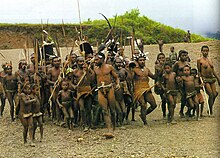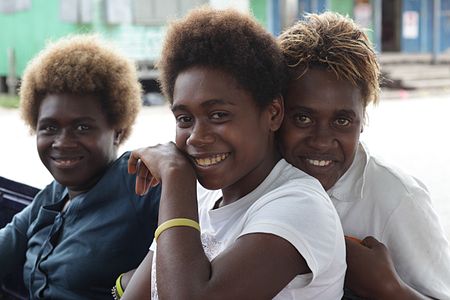Indigenous people of New Guinea
Malagasy people |
The
Linguistically, Papuans speak languages from the many families of
The term "Papuan" is used in a wider sense in linguistics and anthropology. In linguistics, "

Languages
Papuan ethnic groups

The following indigenous peoples live within the modern borders of Indonesia and Papua New Guinea. Austronesian-speaking (AN) groups are given in italics.
Indonesia
West Papua
Papuan ethnic groups / tribes in the Indonesian province of West Papua include Arfak, Borai, Doreri, Hatam, Irarutu, Koiwai, Kuri, Madewana, Mairasi, Maniwak, Mbaham, Matta, Meiah, Miere, Meyah, Moire, Moru, Moskona, Napiti, Oburauw, Roon, Roswar, Sebyar, Sougb, Soviar, Sumuri, Wamesa, Warumba, Waruri, Wondama.[7]
Southwest Papua
Papuan ethnic groups / tribes in the Indonesian province of Southwest Papua include Abun, Ambel, Batanta, Biak (Betew, Kafdaron, Bikar, Usba, Wardo), Biga, Butlih, Domu, Fiawat, Imekko (Inanwatan-Bira, Matemani-Iwaro, Kais-Awe, Kokoda-Emeyode), Irires, Ma'ya (Kawe, Langanyan, Wawiyai), Matbat, Maybrat (Ayamaru, Mare, Karon Dori, Ayfat, Aytinyo), Meyah, Moi-Ma'ya, Moi, Mpur, Nerigo, Tehit, Tepin, Yahadian, Yaben-Konda.[7]
Papua
Papuan ethnic groups/tribes in the Indonesian province of Papua include:[8]
| Jayapura City |
|
|---|---|
| Jayapura Regency |
|
| Sarmi Regency |
|
| Keerom Regency |
|
| Biak Numfor Regency |
|
| Waropen Regency |
|
| Yapen Islands Regency |
|
| Mamberamo Regency |
Highland Papua
Papuan ethnic groups/tribes in the Indonesian province of Highland Papua include:[8]
| Jayawijaya Regency |
|
|---|---|
| Pegunungan Bintang Regency |
|
| Tolikara Regency |
|
| Yahukimo Regency |
|
Central Papua
Papuan ethnic groups/tribes in the Indonesian province of Central Papua include:[8]
| Mimika Regency |
|
|---|---|
| Nabire Regency[9] |
|
| Painai Regency |
|
| Puncak Jaya Regency |
|
South Papua
Papuan ethnic groups/tribes in the Indonesian province of South Papua include:[8]
| Merauke Regency |
|
|---|---|
| Asmat Regency | |
| Mappi Regency |
|
| Boven Digoel Regency |
Papua New Guinea
Bismarck Archipelago
-
Girls from Papua New Guinea
-
Papuan people in folk dress in Jakarta
-
Newly married Kayu Batu couple in Jayapura, Indonesia
Origin and genetics
The origin of Papuans is generally associated with the first settlement of Australasia by a lineage dubbed 'Australasians' or 'Australo-Papuans' during the Initial Upper Paleolithic, which is "ascribed to a population movement with uniform genetic features and material culture" (Ancient East Eurasians), and sharing deep ancestry with modern East Asian peoples and other Asia-Pacific groups.[10][11][12] It is estimated that people reached Sahul (the geological continent consisting of Australia and New Guinea) between 50,000 and 37,000 years ago. Rising sea levels separated New Guinea from Australia about 10,000 years ago. However, Aboriginal Australians and Papuans had diverged genetically much earlier, around 40,000 years BP. Papuans are more closely related to Melanesians than to Aboriginal Australians.[13][12]
Haplogroups
The majority of Papuan
Autosomal DNA
The genetic makeup of Papuans is primarily derived from Ancient East Eurasians, which relates them to other mainland Asian groups such as the "AASI", Andamanese, as well as East/Southeast Asians, although Papuans may have also received some gene flow from an earlier group (xOoA), around 2%,[16] next to additional archaic Denisovan admixture in the Sahul region. Papuans may habor varying degrees of deep admixture from "a lineage basal to West and East-Eurasians which occurred sometimes between 45 and 38kya", although they are generally regarded "as a simple sister group of Tianyuan" ("Basal East Asians").[11][12][10]

There is evidence that the ancestors of Papuans and related groups "underwent a strong bottleneck before the settlement of the region, and separated around 20,000–40,000 years ago".[17]
Papuans display pronounced genetic diversity, explained through isolation and drift between different subgroups after the settlement of New Guinea. The most notable differentiation was found to be between Highlanders and Lowlanders. Papuan Highlanders fall into three clusters, but form a single clade compared against Lowlanders. The Highlanders underwent a population bottleneck around 10,000 years ago, associated with the adaption of Neolithic lifestyles. Papuan Lowlanders display increased diversity and can be broadly differentiated into a Southern Lowlander cluster and a Northern Lowlander cluster. The genetic differentiation among Papuans is suggested to date back at least 20kya, while the sub-structure among Highlanders dates back around 10kya, with higher diversity among western Highlanders than Eastern ones. The genetic diversity is paralleled by linguistic and cultural diversity.[18]
Archaic introgression
Based on his genetic studies of the
ASPM gene
In a 2005 study of ASPM gene variants, Mekel-Bobrov et al. found that the Papuan people have among the highest rate of the newly evolved ASPM Haplogroup D, at 59.4% occurrence of the approximately 6,000-year-old allele.[21] While it is not yet known exactly what selective advantage is provided by this gene variant, the haplogroup D allele is thought to be positively selected in populations and to confer some substantial advantage that has caused its frequency to rapidly increase.
Notable people
- Abba Bina, Papua New Guinean businessman and politician
- Archie Thompson, former Australian soccer player
- Elie Aiboy, former Indonesian footballer
- Marlina Flassy, Indonesian anthropologist and the first woman to be appointed Dean of Cenderawasih University
- Frans Kaisiepo, 4th Governor of Papua and National Hero of Indonesia
- Nitya Krishinda Maheswari, Indonesian badminton player and 2014 Asian Games women's doubles gold medalist
- Nowela Auparay, professional singer and Indonesian Idol winner
- Peter O'Neill, 7th Prime Minister of Papua New Guinea
- Freddy Numberi, Indonesian politician and former Minister of Transportation
- Raema Lisa Rumbewas, Indonesian weightlifter and silver medallist at the 2000 and 2004 Summer Olympics
- Boaz Solossa, Indonesian footballer
- Titus Bonai, Indonesian footballer
- Ricky Kambuaya, Indonesian footballer
- Michael Somare, former Prime Minister of Papua New Guinea
- Heather Watson, English female tennis player
- Benny Wenda, West Papuan independence leader.
- Machmud Singgirei Rumagesan, King of Sekar and National Hero of Indonesia
- Abdul Hakim Achmad Aituarauw, Member of People's Representative Council
- Alwin Komolong
- Kusuga Komolong
- Saiful Islam Al-Payage, Indonesian Islamic preacher
See also
- Aboriginal Australians
- Indigenous Australians
- Koteka Tribal Assembly
- List of ethnic groups of West Papua
- Malagasy people(Africa)
- Moluccans (to the west of New Guinea)
- Negrito (Southeast Asia)
- Papua conflict
- Proto-Australoid
- Stéphane Breton (filmmaker)
- Torres Strait Islanders between New Guinea and mainland Australia (including the Meriam people, whose language family is otherwise found in New Guinea)
References
- ^ From the Malay word pəpuah 'curly hair'. "Papuan". Oxford English Dictionary (Online ed.). Oxford University Press. (Subscription or participating institution membership required.)
- ^ Traditional Melanesia at the Encyclopædia Britannica
- ^ PMID 18208337.
- PMID 28854687.
- ISBN 978-3-11-028642-7.
- ^ "Forthcoming Series: Papuan Languages". Brill. Retrieved 2023-12-14.
- ^ ISBN 978-602-356-318-0.
- ^ a b c d "Pemerintah Provinsi Papua". www.papua.go.id. Retrieved 2021-02-16.
- ^ "Bupati Mesak Siap Bangun Asrama Siswa Suku Terasing di Nabire – Pemerintah Kabupaten Nabire". Pemerintah Kabupaten Nabire – "Nabire Aman, Mandiri dan Sejahtera". Retrieved 2022-10-25.
- ^ PMID 36553640.
- ^ ISSN 2770-5005.
- ^ PMID 35445261.
Taken together with a lower bound of the final settlement of Sahul at 37 kya it is reasonable to describe Papuans as either an almost even mixture between East-Eurasians and a lineage basal to West and East-Eurasians which occurred sometimes between 45 and 38kya, or as a sister lineage of East-Eurasians with or without a minor basal OoA or xOoA contribution. We here chose to parsimoniously describe Papuans as a simple sister group of Tianyuan, cautioning that this may be just one out of six equifinal possibilities.
- PMID 32483274.
- ^ 崎谷, 満. "DNA・考古・言語の学際研究が示す新・日本列島史 : 日本人集団・日本語の成立史" [New History of the Japanese Archipelago Revealed by Interdisciplinary Research on DNA, Archeology, and Language]. (No Title) (in Japanese).
- PMC 379223.
- ^ "Almost all living people outside of Africa trace back to a single migration more than 50,000 years ago". www.science.org. Retrieved 2022-08-19.
- ISSN 1476-4687.
- PMID 28912245.
- ^ Carl Zimmer (22 December 2010). "Denisovans Were Neanderthals' Cousins, DNA Analysis Reveals". NYTimes.com.
- PMID 36480515.
- S2CID 30403575.
Further reading
- W. G. Lawes (1882), "New Guinea and Its People", Popular Science Monthly
External links
 Media related to People of Papua at Wikimedia Commons
Media related to People of Papua at Wikimedia Commons



